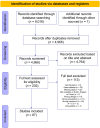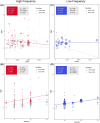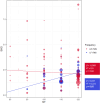More rTMS pulses or more sessions? The impact on treatment outcome for treatment resistant depression
- PMID: 39569643
- PMCID: PMC11884915
- DOI: 10.1111/acps.13768
More rTMS pulses or more sessions? The impact on treatment outcome for treatment resistant depression
Abstract
Background: Repetitive transcranial magnetic stimulation (rTMS) is effective for treatment-resistant depression (TRD). Optimal rTMS parameters remain unclear, especially whether number of sessions or amount of pulses contribute more to treatment outcome. We hypothesize that treatment outcome depends on the number of sessions rather than on the amount of pulses.
Methods: We searched databases for randomized clinical trials (RCTs) on high-frequent (HF) or low-frequent (LF)-rTMS targeting the left or right DLPFC for TRD. Treatment efficacy was measured using standardized mean difference (SMD), calculated from pre- and post-treatment depression scores. Meta-regressions were used to explore linear associations between SMD and rTMS pulses, pulses/session and sessions for HF and LF-rTMS, separately for active and sham-rTMS. If these variables showed no linear association with SMD, we divided the data into quartiles and explored subgroup SMDs.
Results: Eighty-seven RCTs were included: 67 studied HF-rTMS, eleven studied LF-rTMS, and nine studied both. No linear association was found between SMD and amount of pulses or pulses/session for HF and LF-rTMS. Subgroup analyses showed the largest SMDs for 1200-1500 HF-pulses/session and 360-450 LF-pulses/session. The number of sessions was significantly associated with SMD for active HF (β = 0.09, p < 0.05) and LF-rTMS (β = 0.06, p < 0.01). Thirty was the maximal number of sessions, in the included RCTs.
Conclusion: More rTMS sessions, but not more pulses, were associated with improved treatment outcome, in both HF and LF-rTMS. Our findings suggest that 1200-1500 HF-pulses/session and 360-450 LF-pulses/session are already sufficient, and that a treatment course should consist of least 30 sessions for higher chance of response.
Keywords: meta‐analysis; meta‐regression; repetitive transcranial magnetic stimulation; treatment resistant depression.
© 2024 The Author(s). Acta Psychiatrica Scandinavica published by John Wiley & Sons Ltd.
Conflict of interest statement
The authors report no biomedical financial interests or potential conflicts of interests.
Figures





References
-
- Rush AJ, Trivedi MH, Wisniewski SR, et al. Acute and longer‐term outcomes in depressed outpatients requiring one or several treatment steps: a STAR*D report. Am J Psychiatry. 2006;163(11):1905‐1917. - PubMed
-
- Gaynes BN, Lux L, Gartlehner G, et al. Defining treatment‐resistant depression. Depress Anxiety. 2020;37(2):134‐145. - PubMed
-
- Gronemann FH, Jorgensen MB, Nordentoft M, Andersen PK, Osler M. Treatment‐resistant depression and risk of all‐cause mortality and suicidality in Danish patients with major depression. J Psychiatr Res. 2021;135:197‐202. - PubMed
-
- Lefaucheur JP, Aleman A, Baeken C, et al. Evidence‐based guidelines on the therapeutic use of repetitive transcranial magnetic stimulation (rTMS): an update (2014‐2018). Clin Neurophysiol. 2020;131(2):474‐528. - PubMed
-
- Lefaucheur JP, Andre‐Obadia N, Antal A, et al. Evidence‐based guidelines on the therapeutic use of repetitive transcranial magnetic stimulation (rTMS). Clin Neurophysiol. 2014;125(11):2150‐2206. - PubMed
Publication types
Grants and funding
LinkOut - more resources
Full Text Sources
Research Materials
Miscellaneous

